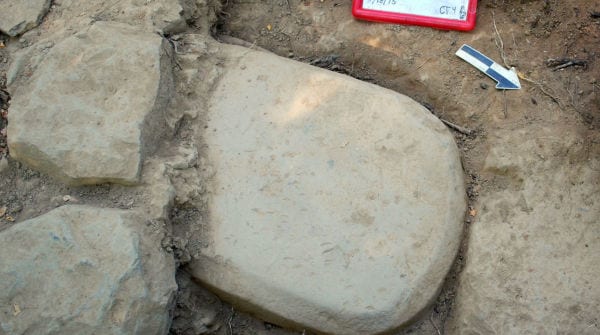Secondo gli scienziati il testo riportato sulla pietra potrebbe dare un contributo decisivo alla ricostruzione del linguaggio di questo popolo.
Italian newspaper Il Tirreno in Italy covered SMU sponsored research at Italy’s Poggio Colla site where archaeologists have found what may be rare sacred text in the lost language of the Etruscans. The text is inscribed on a large 6th century BC sandstone slab and could reveal name of the god or goddess that was worshipped at the site.
The article, “Una stele per svelare il linguaggio degli Etruschi,” published March 31.
EXCERPT:
Il Tirreno
FIRENZE. E’ una scoperta che potrebbe dare un contributo decisivo per ricostruire il linguaggio degli Etruschi. Un gruppo di ricercatori del Mugello Valley Archaeological Project ha portato alla luce una stele che riporta una scrittura etrusca. La scoperta è stata fatta nel sito di Poggio Colla in Toscana. La pietra, che pesa 227 chili ed è alta poco più di un metro, faceva parte di un tempio sacro che 2500 anni fa venne demolito per costruirne uno più grande.La stele si presenta ben conservata. Contiene 70 lettere leggibili e segni di punteggiatura, caratteristiche che la rendono uno dei più lunghi esempi di scrittura etrusca mai rinvenuti finora. Gli scienziati sono convinti che le parole e i concetti sulla stele siano una rarissima testimonianza di questa civiltà, considerando che finora le nostre conoscenze sugli etruschi sono legate unicamente a, necropoli, tombe e oggetti funerari. La traduzione del testo sarà affidata all’Università del Massachusetts di Amherst.
“Le scoperte etrusche in Mugello, che hanno portato poi alla realizzazione del bellissimo Museo comprensoriale di Dicomano, trovano con la stele scavata dal Mugello Archaeological Project un punto di riferimento essenziale”. Lo afferma il presidente del Consiglio regionale Eugenio Giani, in una nota sul ritrovamento nel sito di Poggio Colla.
Follow SMUResearch.com on twitter at @smuresearch.
SMU is a nationally ranked private university in Dallas founded 100 years ago. Today, SMU enrolls nearly 11,000 students who benefit from the academic opportunities and international reach of seven degree-granting schools. For more information see www.smu.edu.
SMU has an uplink facility located on campus for live TV, radio, or online interviews. To speak with an SMU expert or book an SMU guest in the studio, call SMU News & Communications at 214-768-7650.


 NASA data leads to rare discovery: Earth’s moon wandered off axis billions of years ago
NASA data leads to rare discovery: Earth’s moon wandered off axis billions of years ago Good news! You’re likely burning more calories than you thought
Good news! You’re likely burning more calories than you thought
 New look at Pizarro’s conquest of Inca reveals foot soldiers were awed by empire’s grandeur
New look at Pizarro’s conquest of Inca reveals foot soldiers were awed by empire’s grandeur
 Charity, social justice and earth-friendly activism replace big houses, diamond rings and ostentatious living for status seekers
Charity, social justice and earth-friendly activism replace big houses, diamond rings and ostentatious living for status seekers